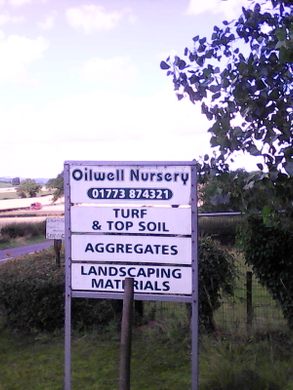Site of the UK’s First Oil Well
Britain doesn't have a lot of petroleum reserves on dry land but this well was the first to strike oil.
The UK’s, currently declining, North Sea Oil reserves are well known. Less well known is the fact that since the 1940s the UK has had a small, but not insignificant, onshore oil (and gas) industry which has expanded greatly since the 1980s. What is even less well known is the fact that the first oil well in the mainland of the UK struck oil in 1919 and that this oil well was kept in production until the end of WW2.
The top of the well is still easily found on the site of a garden centre/plant nursery near Tibshelf and oil still seeps up to the surface (the garden centre actually sells small souvenir bottles of Hardstoft Oil). A marker board identifies the well position within the nursery, which, conveniently, is called Oilwell Nursery and the village name boards proudly announce Tibshelf as “Site of Britain’s first inland oil well”. There are also some concrete foundations next to the well head.
Early in WW1, in an attempt to reduce Britain’s dependence on imported oil, the government decided to investigate potential of resources in the UK. An Oil Production Committee was established and the Derbyshire Coalfield was one of three areas identified as potential productive areas. Several coal mines in the area were well known for producing an oily seepage from strata above the coal seams. Old coal miners used to recall coming home from work smelling of oil as well as having a mixture of oil and coal dust thickly caked onto their working clothes. The other areas were in Staffordshire and the Lothians of Scotland and eventually 13 productive wells were established. In the later case there was already an established oil refining industry based on the extraction of oil from oil shale. When oil was discovered this was where the oil was shipped to by rail.
American drillers were employed to drill test bores. British drilling equipment was not suitable and the USA, at that time neutral, had banned sale of strategic equipment (including drilling gear). However this was circumvented by contracting American companies and renting their equipment.
Amazingly, in time of war, it took three and a half years to finalise contracts to allow drilling to proceed. The first well at Hardstoft was opened in a “spudding” ceremony on 15th October 1918, with the war virtually over.
The first Hardstoft well was drilled to a depth of 3070 feet. The first oil flowed from the well under its own pressure on 7 June 1919. It was announced in the House of Commons that the oil was flowing at 11 Barrels a day. For a while oil was transported in road tankers to the rail head for transport to Scotland by rail tankers but eventually a 4500 foot long gravity fed pipeline was installed between the well and rail head. Two other wells were sunk at Hardstoft. One produced only water under sufficient pressure to damage the well casing and the other produced no oil but a lot of gas which was used on site for heating the drillers’ accommodation and steam raising.
Apart from the Hardstoft well, and one well in Scotland, all of the wells produced in this project were shut down in 1921 due to falling production. However, despite falling production, the Hardstoft well, was kept going, by pumping oil out of the well (from 1924), until the end of WW2.
The Atlas Obscura Podcast is Back!










Follow us on Twitter to get the latest on the world's hidden wonders.
Like us on Facebook to get the latest on the world's hidden wonders.
Follow us on Twitter Like us on Facebook